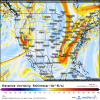Webberweather53
Meteorologist
It happens the vast majority of the time, anticyclones that break from underneath south of Greenland literally push the storm track further north which causes the jet stream to accelerate by angular momentum conservation thereby causing heights to fall in response near the climatological position of the Icelandic Low after the anticyclone has run its course. It’s rare to have an anticyclone break south of Greenland and become a strong negative NAO for more than a few days, the preferred area for anticyclonic wave breaking becoming negative NAOs is near Western Europe and Scandinavia at the exit region of the Atlantic jet.Is that true all the time? The 6z gefs nicely retrogrades the war to a nice full block up top, with a look similar to the weeklies. Are you saying if that happens it's likely to be a very temporary fixture?
Retrograding that ridge to a greenland block seems the only to way to get a -nao in the near term, as theres a permanent trough near Scandinavia.





















